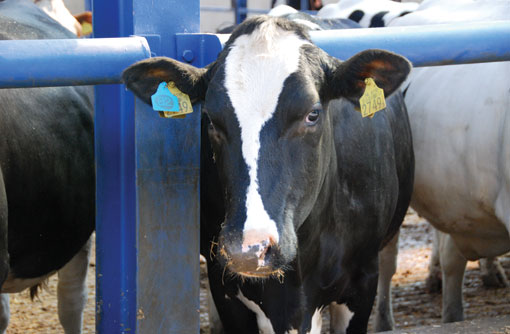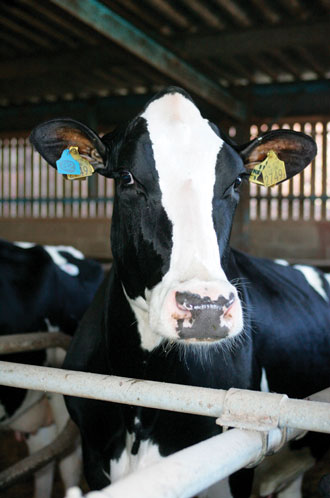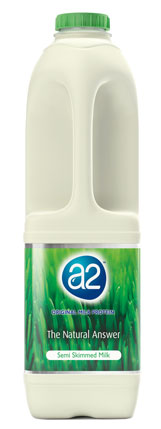Milking more money from A2 production

A2 milk will be hitting the supermarket shelves this month. Rhian Price speaks to a Shropshire dairy farmer who has taken the plunge to produce the premium milk product.
For Shropshire dairy farmer Andrew Evans, investing time and capital in A2 milk production has provided his business with security and peace of mind at a time when many milk producers are facing uncertainty in the marketplace.
After his previous milk buyer reduced its price by about 2.5p/litre, Mr Evans became concerned about its stability and quickly handed in his notice.

“We became very worried about the future viability of the business and wanted to source a better price.
“We had been promised a bonus-added contract, but nothing materialised,” he says. At the time, Mr Evans admits he was leaving his previous milk buyer, not knowing where he was going.
Luckily he managed to sign a new contract and started supplying Robert Wiseman Dairies in September 2011. It was a decision that has paid dividends and came just at the right time.
Soon after, Wiseman approached him with the prospect of supplying A2 milk on an exclusive two-year contract. A2 milk contains a different protein to that in conventional A1 milk, which is hoped will reduce the digestive dysfunctional symptoms experienced by some people.
With an additional 2.5p/litre premium for A2 milk in comparison to A1 on a Wiseman contract, it may seem a bit of a no-brainer, but it wasn’t a decision he entered into lightly.
It took months of careful consideration and planning with his dairy consultant – forecasting figures and weighing up the benefits of A2 in comparison to supplying A1 milk – before he took a leap of faith into the unknown.
After a whirlwind eight months he is now just days away from supplying Wiseman with the first tanker-load of A2 milk. But it hasn’t all been smooth sailing. To start with the entire herd had to be tested for the A2 beta-casein protein.
“A team of specialists from Wiseman came and took follicle samples from the animals’ ears and they were sent off for testing at their labs in Ireland,” explains Mr Evans. Results showed that 37% of the herd already carried the A2/A2 gene, which was significant considering the UK average ranges from 20-54%. The next step was sourcing A2 animals to make up the shortfall, which Mr Evans says proved to be one of the biggest challenges.
“I first went out to Holland in March 2012. But since then I have been to Germany and revisited Holland again to buy more heifers.”
In total, Mr Evans has bought nearly 600 heifers and two-thirds of his herd is now A2/A2.
Being able to get on to a premium contract has been a catalyst for a long-awaited expansion. The subsidy of £350 a cow offered by Wiseman to buy in A2 stock has provided Mr Evans with the capital to increase his dairy herd nearly twofold.
On top of this, Wiseman is giving producers an additional 1p/litre in the first year for any original cows that test positive for the A2 gene. This equates to 3.5p/litre in total.
“If it wasn’t for the extra money in the current climate we wouldn’t have been able to expand,” says Mr Evans.
The decision to convert to A2 and expand his herd has led to a complete re-evaluation of the farm’s existing management system.
In July, the process of separating the A2 and A1 milkers began. First the cows were tagged with blue tags to differentiate them from the remaining herd, before they were moved into separate housing.
To ensure the A2 milk doesn’t become contaminated with A1, the A2 cows will be milked first through the 60-point rotary parlour. Then the parlour will be rotated around to its wash position and compressed air will blow the A2 milk into the new 22,000-litre bulk tank.
The pipes will then have to be switched over to the second bulk tank ready for the A1 milkers, and once milking is complete, two different tankers come to pick up the milk.

To facilitate the additional cow numbers and with the aim of increasing production to 10,000 litres a cow a year, Mr Evans has now increased their daily milking to three times a day and the herd has further been divided into low yielders and high yielders.
“In order to monitor intakes more closely, we’ve decided to keep the high yielders indoors all year round and milk them three times a day.
“Meanwhile, the lower yielders – those producing 28-30 litres or less – will go out to grass in March, weather permitting.”
To accommodate this, a new shed is in the process of being built and two existing loose housing buildings have had to be renovated to provide an additional 650 sand cubicles.
But the extra workload has come at a cost.
“Separating the cows has been a big drawback, because we now require two more people to help with handling.
“Also, the downtime between the two batches in the parlour is quite significant, especially when you’re milking three times a day,” he explains.
In total, Mr Evans estimates that the time lost in between milking each day will lose them one hour a day, at a cost of 1p/litre.
Any new venture can be daunting and a big risk to take. But after Wiseman announced a 2p/litre price cut in June, Mr Evans says he can’t afford to be too hesitant.
“Initially we were going to wait and see if A2 got off the ground, but because of the further price reduction with A1 milk we are looking to fast-track, which will mean selling the A1 cows and converting to A2 quicker than originally planned.”
Currently, the herd is running at 60% A2 efficiency, but by Christmas, Mr Evans hopes to be at 80% by selling some A1 milkers and buying in replacements.
In time, Mr Evans hopes to breed all his own replacements by using A2 beta-casein approved AI bulls.
Looking ahead to the future, Mr Evans says he sees a much brighter horizon and is confident A2 milk will hit the ground running in the UK. “It gives us confidence knowing that in Australia A2 milk has been a big hit.”
The proof, however, will be in A2 milk sales figures next year.
A2 milk is set to hit supermarket shelves in the UK and Ireland for the first time in September, but it is by no means a new concept.
In Australia, retailers have been selling A2 milk for a number of years and it is successfully catching a 6% value share of the milk market.
The UK concept is part of a joint venture between A2 Corporate and Robert Wiseman Dairies, which began last autumn, explains Pete Nicholson, milk procurement director at Wiseman.

Currently 14 producers – all within the West Midlands area – are supplying Wiseman with A2 milk this month on a two-year contract. But there could be an opportunity in the future to take on more if the market allows.
“We have a responsibility to ensure we don’t over supply and we won’t be looking to expand until the market gathers pace,” says Mr Nicholson.
But he says it could take up to 18 months to penetrate the market.
“With any new product they always tend to have a slow start and you have to stick in there.
“That is why we are giving a two-year guarantee to all our suppliers so the risk is shared,” he explains.
Sean Uprichard, CEO of A2 milk UK, is confident that in time A2 milk will revitalise the UK milk market.
“I think milk is too cheap. A2 will offer the opportunity to establish a consumer benchmark of what milk is worth and give retailers the scope to move the price forward.
“As an added-value proposition sold at a premium price it has the ability to further drive value to be shared across the supply chain from retailers, to processors and farmers,” he explains.
What are your thoughts on A2 milk? Get involved in the discussion online
